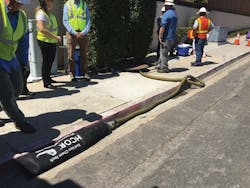Filtration: Addressing Priority Pollutants
In 2012, the U.S. Environmental Protection Agency (EPA) discovered the environmental impacts of substructures and utility vault discharge and the negative effects these pollutants have on agriculture, reservoirs and oceans. It created a general permit to regulate where and how this contaminated water could be discharged to U.S. waters.
Utility companies found the only way to eliminate contaminated water was to dewater flooded substructures and utility vaults with a vacuum truck and treat or dispose of it in hazmat facilities. Vacuum trucks can be costly to the ratepayer due to trucker pump costs, vault repair delays and downtime, utility worker overtime, power grid rerouting, and hazmat disposal costs. In addition, the use of in-ground utility vault sump pumps was prohibited in substructures.
Utility company approaches to removing pollutants from substructures historically have been limited. Prior to 2012, routine dumping to U.S. waters without regard to dissolved pollutant levels went unregulated. With the new EPA regulations, the need for a new solution for utility companies to allow direct discharge of treated water from vaults was paramount.
Changing Standards
A variety of sand filters was available for sand and debris removal and some were made with polypropylene or polyester fabric, which absorbed a small amount of oil and grease. In the past, utility companies took advantage of the low cost and low efficiency of these filters to filter moderately visibly dirty water. They have, however, generally proven ineffective for high-pressure filtration of dissolved pollutants and toxic heavy metals to meet EPA-mandated discharge water quality criteria.
As of July 1, 2015, the General NPDES Permit for Discharge from Utility Vaults and Underground Substructures to Waters of the U.S. officially updated its standards to include removal of the top 126 priority pollutants listed by EPA in addition to diesel range, oil range and gasoline range organics. Monitoring by EPA and utility companies found these pollutants were present at varying levels. The EPA mandate also requires the removal of toxic insecticides from runoff in vaults and polychlorinated biphenyl contamination from transformers.
Filtration Solution
Red Lion Chem Tech in San Diego developed the Hydrocarbon and Contaminants Removal filter for San Diego Gas & Electric, a Sempra Utility, to solve its discharge problems.
The single-pass pressure filter system addresses the 126 EPA priority pollutants and was designed to remove hydrocarbons and other contaminants from wastewater and storm water runoff that accumulates in utility vaults and substructures. The filter uses a portable submersible pump, and the filter's six-layer, oleophilic polyester fiber sleeve captures total suspended solids and hexane-extractable materials such as oil, diesel and gasoline. A continuous ion exchange chamber removes toxic heavy metals, and a three-dimensional inner perfusion layer, comprised of agglomerated, oleophilic nanomaterials, removes dissolved contaminants, particularly those on the priority pollutants list of the Clean Water Act.
The agglomerated oleophilic nanomaterial, as found in the filter sleeve in micron-sized aggregates, creates a clathrate structure, which captures pollutants and permanently binds them. The pollutants cannot leach out of the filter. Nanomaterial can capture up to 1,000 times its weight in targeted substances with its inherently high surface area. For example, the 1 lb of aggregated nanomaterial used in the filter sleeve has an adsorption area of 52 million sq ft with a surface modified specifically for hydrocarbon bonding.
Results
The priority pollutants addressed by EPA were validated against the filter under controlled field conditions with an overall concordance of 98.5%. This compares with EPA water quality testing criteria, wherein 97.4% of all pollutants tested were equal to or below EPA water quality criteria and the average reduction was 90% for all pollutants.
The filter was tested on numerous substructures and utility vaults for San Diego Gas & Electric. The contents of a 5,000-gal vacuum truck used to pump a utility vault were transported on the day of collection to a contained testing site. Pre- and post-filtration water samples were analyzed. Discharge of filtered water complied with EPA-mandated water quality criteria.
The filter sleeve provided protection to the beneficial use of utility vault discharged water to storm drains, and allowed the utility company to be in compliance with the enhanced requirements of the NPDES permits. It put the utility company back in control of its water discharge operations. This also will reduce use of vacuum trucks, reduce transportation and disposal fees, shorten downtime and reduce costs of electrical power grid rerouting for prolonged periods of time, as well as reduce labor costs and delays for the utility.
In the end, the use of the filter allowed for the safe discharge of substructure and utility vault water to storm drains to meet the EPA mandate and protect the environment, agricultural water, reservoirs and oceans for future generations.
Download: Here
